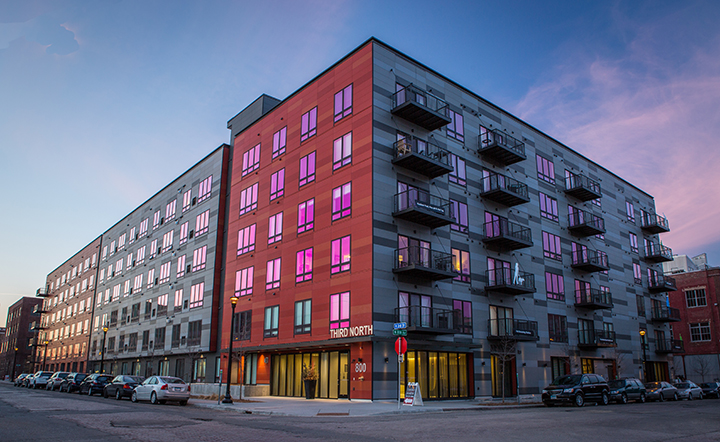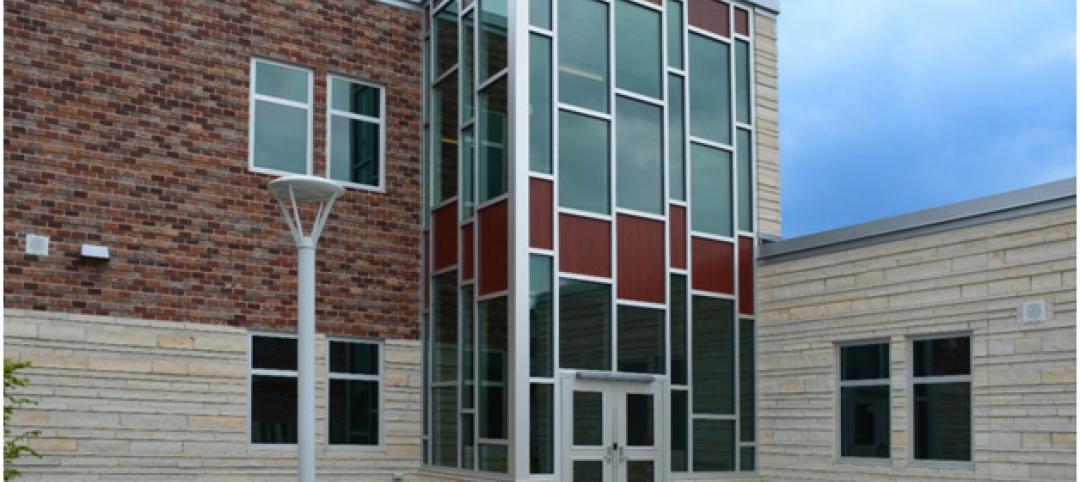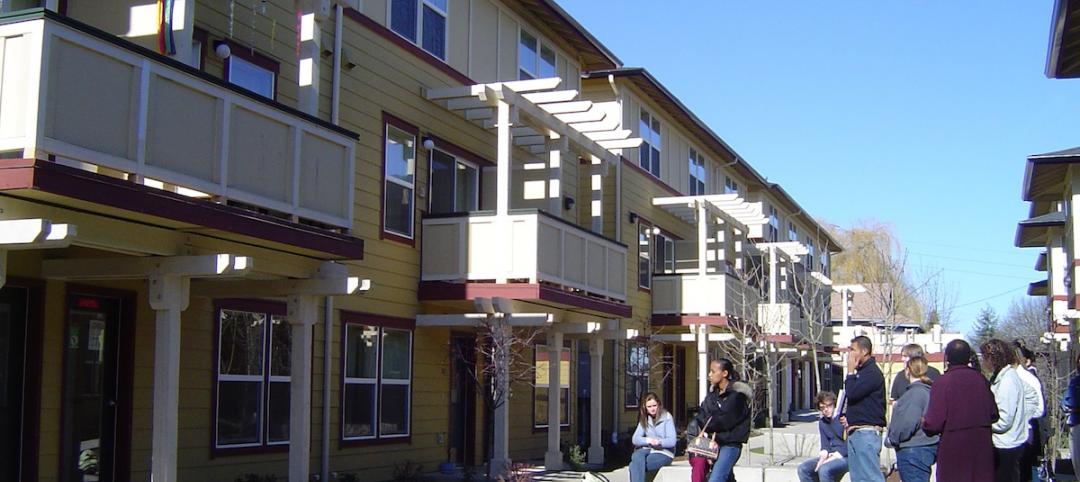Minneapolis’ North Loop neighborhood, like many close-in urban environments, is a community in transition. Over the past decade, property owners and developers have gradually blended and adapted historic buildings and warehouses with new residential blocks and modern amenities.
Respecting those existing aesthetics while addressing the wishes and needs of a younger generation were key goals for the developers of Third North, a 204-unit apartment complex completed in December 2013. The resulting six-story building manages to pay homage to existing structures without feeling dated.
A warehouse-like massing and the structure’s position abutting the sidewalk on three sides reflect the frontage of nearby warehouses, many of which have been adapted into office space or condos. The building’s U shape conceals residential features, including green space, a dog run, and pool—in the center and rear.
CHALLENGE
Create a modern-feeling façade without contrasting too much with the surrounding neighborhood.SOLUTION
Nichiha’s Illumination series in a blend of six colors offers a shape and pattern reminiscent of nearby historic brick buildings and warehouses.RESULT
Third North complements the varying elevations and façades of the neighborhood while bringing a fresh look to the streetscape.
Cladding selection also played a key role. The designers specified Nichiha’s 18”-by-6’ Illumination Series architectural wall panels in a blend of six colors—divided into swaths of reds and swaths of grays—that combine with a rectilinear shape to complementnearby brick. Simultaneously, the panels’ large, smooth scale and nod to metal help the overall look tilt toward the contemporary.
“The panels have rectangular dimensions, and we have shades of red and gray,” says Maureen Michalski, senior project manager for Schafer Richardson, developer of Third North. “It mirrors the colors of the brick and concrete on nearby historic buildings, but is a fresh, modern take off of it. The use of stacked bond also helps in this regard.”
Moving forward with the material wasn’t completely straightforward, however, prior to the Third North project, the city of Minneapolis didn’t allow fiber cement to cover more than 30% of a building’s façade. The architects submitted for an exception, and Illumination Series’ commercial look, aided by its hidden fastening system and the performance brought by an integrated rainscreen that creates an airspace to allow water to drain away, helped it receive an allowance. In the end, the city and the community were equally pleased with the finished product, potentially paving the way for similar applications in the future.
Along with its eye-catching aesthetics, the market-rate apartments offer a host of interior and exterior features attractive to the young renters flocking to the walkable, transit-oriented North Loop. In keeping with the active mindset that proliferates Minneapolis, the complex includes extensive fitness facilities along with the pool and outdoor green space, as well as a bicycle maintenance room for two-wheeled commuters.
In addition to the outdoor off-leash area, a dog grooming room caters to resident pet owners. A rentable guest suite, a club room, and outdoor seating round out the extensive list of communal comforts.
The units themselves boast open floor plans and feature stainless steel Energy Star appliances and efficient lighting, with several finish level options from which to choose.
With its lengthy list of amenities, an ideal location, and eye-catching aesthetics, Third North has been a welcome addition to the neighborhood—one that’s likely to fill up fast.
For more information about Illumination Series and other Nichiha products, please visit: www.nichiha.com.
Related Stories
Building Enclosure Systems | Apr 12, 2016
Water Vapor Migration 101 [AIA course]
This course will describe how to select vapor retarders to control moisture migration and prevent condensation within the building enclosure. To earn 1.0 AIA CES HSW learning units, study the article carefully and take the exam.
| Jan 28, 2016
AIA CES class: The rainscreen approach to a better building envelope
Building envelope expert Bradley Carmichael of Hoffmann Architects explains how rainscreen wall systems work and evaluates the effectiveness of various rain-control methods, including mass walls, perfect barriers, and masonry veneers. This AIA/CES class is worth 1.0 learning unit.
| Jan 14, 2016
How to succeed with EIFS: exterior insulation and finish systems
This AIA CES Discovery course discusses the six elements of an EIFS wall assembly; common EIFS failures and how to prevent them; and EIFS and sustainability.
Insulation | Oct 19, 2015
The expert’s guide to insulation materials
Even the best-designed envelopes can be undermined by thermal bridging in areas where insulation is deficient. Building envelope experts offers advice.
Building Enclosure Systems | Aug 11, 2015
Deriving value from coordinated building enclosure shop drawings
Building enclosure shop drawings play a critical role in guarding against common performance, cost, and schedule pitfalls associated with the transitions between adjacent enclosure components. Engineers with Simpson Gumpertz & Heger provide tips for success.
Sports and Recreational Facilities | Jul 23, 2015
Japan announces new plan for Olympic Stadium
The country moves on from Zaha Hadid Architects, creators of the original stadium design scrapped last week.
Sponsored | Building Enclosure Systems | Jul 20, 2015
Fire Rated Curtain Wall Performance in Dramatic Weather Conditions
Materials selected for the building envelope had to protect occupants from Wisconsin's weather, as well as ensuring their comfort.
Multifamily Housing | Mar 16, 2015
New Jersey Supreme Court puts control of affordable housing agency in the courts
The court said the state’s affordable housing agency had failed to do its job, and effectively transferred the agency's regulatory authority to lower courts.
Brick and Masonry | Feb 5, 2015
3D-printed 'cool brick' may provide cooling solution for arid locations
Cool Brick is made of porous ceramic bricks set in mortar. The bricks absorb water, which cools the air as it passes through the unit.
















